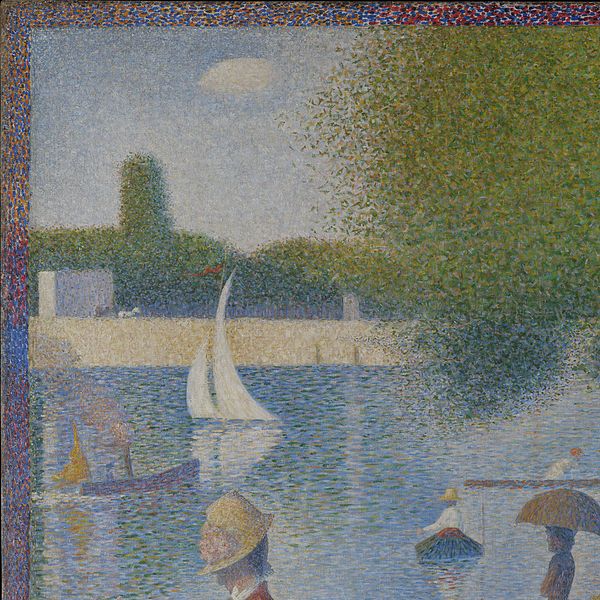Georges Seurat, A Sunday Afternoon on the Island of La Grande Jatte
Georges Seurat (1859-1891) was born in Paris and trained at the École des Beaux-Arts. He was dedicated to the clarity of structure that he found in Classical relief sculpture, and to the seemingly systematic but actually quite emotive use of color suggested by optics and color theory. He was particularly interested in the “law of the simultaneous contrast of the colors” formulated by Michel-Eugene Chevreul in the 1820s. Chevreul observed that adjacent objects not only cast reflections of their own color onto their neighbors, but also create in them the effect of the complementary color. Thus, when a blue object is set next to a yellow one, the eye will detect in the blue object a trace of purple, the complement of yellow, and in the yellow object a trace of orange, the complement of blue.
Seurat explored how color hues and tones adjacent to one another create this visual effect of a third color. He studied carefully which hues could be combined, and in what proportions to produce the effect of a particular color. His goal was to find ways to create retinal vibrations that enlivened the painted surface. He painted in distinctive short, multi-directional strokes of almost pure color, in what came to be known by the various names of “Divisionism,” “Pointillism,” and “Neo-Impressionism.” In theory, these juxtaposed small strokes of colors would merge in the viewer’s eye to produce the impression of other colors.

Seurat’s monumental painting A Sunday Afternoon on the Island of La Grande Jatte was first exhibited at the eighth and final Impressionist exhibition in 1886. The painting contained 11 colors, with the purest hue of each that he could find. He laid these out in a single row on his palette, while creating a second, upper row of the same colors mixed with white and third lower row mixed with black. He painted the entire canvas using the range of colors. When viewed from a distance of about 9 feet, the painting reads as figures in a park rendered in many colors and tones; but when viewed from a distance of 3 feet, the individual marks of color become more distinct and the forms begin to dissolve into abstraction.

The painting represents a sunny Sunday afternoon, the newly designated official day off for French working families to spend time together. The park, on the island of the Grande Jatte, just west of Paris, was accessible by train. The figures represent a range of lower-middle-class “types” that would have been easily recognizable to the nineteenth-century viewer, such as the strolling man and his companion to the right, usually identified as a boulevardier (or citified dandy) and a cocotte (a single woman of the demi-monde), or the canotier (working-class oarsman) to the left.[1]
- Marilyn Stokstad, Art History, vol. 2, 4th ed, (Upper Saddle River, NJ: Prentice Hall: 2011), 933. ↵

